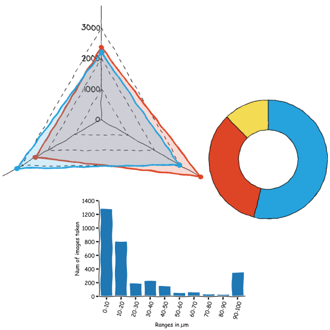Discover the capabilities of WaveMode AFM in characterizing bottlebrush polymers with unprecedented detail and speed, ...

The ultimate tool for nanoscale research from biological molecules to advanced new materials.
The versatile mid-range research AFM that grows with your demands in modes and accessories.
A compact affordable research AFM that is astoundingly easy to use, with more than 30 modes and options.
Fastest reliable sub-Angstrom surface roughness metrology.
Bringing the power of DriveAFM to a wafer metrology system purpose-built for the requirements of the semiconductor industry.
Measure roughness and other material properties of heavy and large samples up to 300 mm and 45 kg.
For unique requirements, we will design a bespoke AFM solution, leveraging our decades of engineering expertise.
Slide an AFM onto your upright optical microscope turret for a leap in resolution.
One of the smallest ever AFMs, created for integration into custom stages or existing setups.
A flexibly mountable research-grade scan head for integration into custom stages or existing set ups.
What is atomic force microscopy (AFM)? How does AFM work? What AFM modes do I really need? How do I get started with AFM?
Learn how AFM works with cantilever/tip assembly interacting with the sample. Explore CleanDrive technology, calibration methods, and feedback principles for precise nanoscale imaging.
An overview of common AFM modes. To learn about each mode in more detail and see application, view the full article.
We regularly publish detailed reviews providing practical guidance and theoretical background on various AFM applications.
Read detailed technical descriptions about selected AFM techniques and learn how to perform specific measurements on Nanosurf instruments.
A library of links to research papers in which Nanosurf instruments were used.
Learn AFM from our library of recorded webinars, covering different measurement techniques, modes, and areas of application.
Short video clips explaining how to perform different operations on Nanosurf instruments.
Watch a product demonstration to learn about the capabilities of our AFMs.
Short videos of our AFMs.
Browse news articles, press releases and a variety of other articles all around Nanosurf
Browse Héctor Corte-Léon's weekly experiments, for inspiration, entertainment, and to discover everyday applications of AFM.
Héctor here, your AFM expert at Nanosurf calling out for people to share their Friday afternoon experiments. Today I image one of the tiniest hard drives I ever saw.
The story goes something like this. A few months ago I was watching Linus Tech Tips when I came across this video about a microdrive the size of a coin, and I immediately knew I had to image it.
Not only because of its tiny size, but also because it will be a nice addition to my magnetic storage media series (according to the manufacturing date, the drive I got is from 2006-02-28).
The drive itself was not difficult to find, I got one of ebay for about £7, but it was challenging to disassemble as it requires "Y" type screwdrivers (which I don't have), so I had to resort to the old trick of using a sharp blade.
Once opened, it resembled many of the other disks I have seen, just that every component has been miniaturized. Spinning disk, motor, reading arm...
So, the important is question: How does it compare with other hard drives I have imaged in the past? This is when it becomes handy that I included bit density calculations in previous fridayAFM posts... and in other measurements I did but didn't post (because it would be boring seeing MFM images of hard drives all day long).
All we can say at the moment is that the electronics are smaller, maybe because it includes custom-built ICs? (covered in black epoxy), although these could be just the amplification ICs that usually are mounted on the reading arm (here, because of the tiny size, even though they are placed outside, they are still close to the reading/writing sensor).
But is the bit density any different than hard drives from the same era?
Here is the MFM imaging of the disk:
The only thing notable about the MFM imaging on this mini disk is that I couldn't disassemble the platter, so I have to image directly on the disk still attached to the drive.
So, how does it compare? Before showing you the comparison with other hard drives, let me show you two interesting hard drives (If I don't show them here, I might not have other chance). I present you the Fujitsu MPC3084AT from 1999.
The weird thing about this drive (the Fujitsu), is the magnetic domain pattern. There is a lot of spacing between tracks. Obviously the writing/reading process can deal with bits closer together, so why are the tracks so large and separated? My hypothesis is that the mechanical movement of the arm (or its electronic controlling circuit) is either not stable enough, and large spacing is needed, or it doesn't have the resolution to have smaller spacing between tracks. This fits well with the fact that the arm is a large structure with 6 read/writing heads, because such large structure is likely to vibrate.
By the way, this was produced about ten years before Fujitsu's hard disc drive division merged with Toshiba. It will be very interesting to see Toshiba's drives before/after and Fujitsu's closer to the merger/acquisition.
The next hard drive goes back another ten years, to an era when it was still consider (for economic reasons) possible to have hard drives as cartridges (eventually this was discarded to be able to reduce tolerances and get rid of dust contamination among other reasons).
The curious thing about this drive is the strong stray field. Using standard 2-pass MFM and a lift height of 300 nm during the second pass, the phase change was still of few degrees (compare with the 0.1 deg of first image... as all these were taken with the same probe). More on the history of Syquest on this youtube video.
Now, without further a do, here is the summary of hard disc drive bit density over the years (at least as it stands right now after my first year with Nanosurf, because I have many more drives waiting to be characterized).
So... the answer is that the Seagate ST 1.2 is no special, its bit density fits perfectly with the drives been produced in 2005-2006. It simply has scaled down mechanics, the spindle shaft takes less of the usable disc surface... and probably the electronics are tailored for these drives, maybe compromising on bit correction algorithms, or de-noising, or algorithms to maintain hard disc drive health (e.g. periodically reading and writing bits to avoid data degradation).
Interestingly, from the graph we can also see the deep about 2008 when the economic crisis. Probably indicating that for a few years spending on development was reduced. We will see a similar deep with the Corona pandemic?
Also worth nothing that the Bernoulli box (1983), seems to have a bit density higher than storage formats coming out at the same time (that or I got the date wrong, or the bit density calculation).
Almost forgot, worth comparing this graph against the one in the Computer History Museum.
Now, for those who missed it, here are the previous posts on magnetic data storage media.
Hopefully, these, and some more questions that I will keep to myself, will be answered in future fridayAFM experiments (or maybe you know and are willing to share the knowledge?).
Stay in touch, and share images if you have other hard drives, I can add them to the graph!

28.10.2025
Discover the capabilities of WaveMode AFM in characterizing bottlebrush polymers with unprecedented detail and speed, ...

27.10.2025
Read this blog and discover advanced alloy engineering and cutting-edge AFM techniques for high-resolution, ...

14.10.2025
Discover how WaveMode technology resolves the tobacco mosaic virus structure under physiological conditions with ...

08.12.2024
Learn how to make a Python code to interface your AFM with a gamepad.

01.10.2024
FridayAFM: learn how the extreme sensitivity of AFM can reveal the glass ageing process.

11.07.2024
FridayAFM: learn how to perform datamining on large sets of AFM data.
Interested in learning more? If you have any questions, please reach out to us, and speak to an AFM expert.
